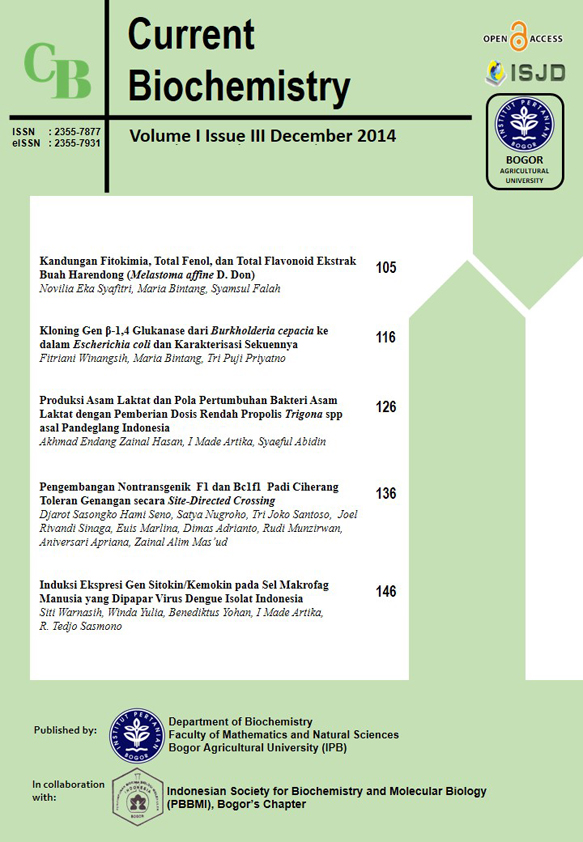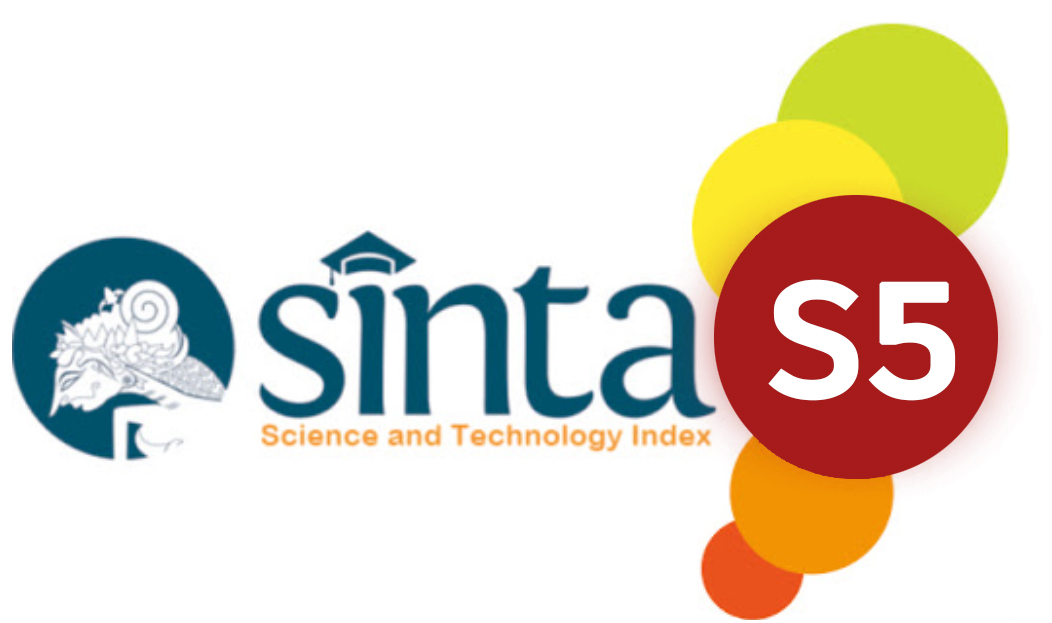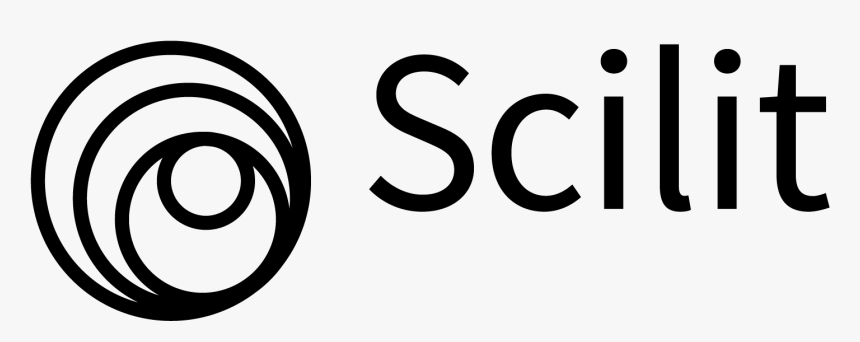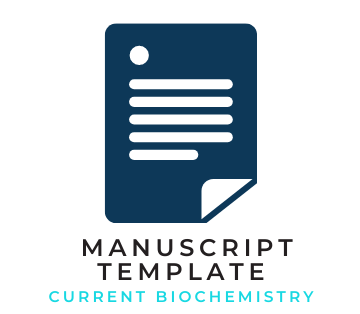Induksi Ekspresi Gen Sitokin/Kemokin pada Sel Makrofag Manusia yang Dipapar Virus Dengue Isolat Indonesia
Abstract
Dengue is one of the world's most important arbovirus disease. Dengue pathogenesis has not been yet fully understood. It has been reported that there is involvement of the host immune factors and viral factors. Several studies have shown that concentrations of cytokines/chemokines on blood are significantly increased during infection and viral factors are also involved in disease severity. Therefore, characterization of host gene expression profiles in response to dengue virus infection of different serotypes could provide input for understanding the pathogenesis of dengue. The purpose of this research was to determine expression profiles of the genes (mRNA) of cytokines/chemokines as immune response that are released by monocyte derived macrophages (MDM) cells (host gene) exposed dengue viruses. Four dengue serotypes of Indonesia isolate were used in this study. Peripheral Blood Mononuclear Cells (PBMCs) were isolated from blood cells of healthy donors by Ficoll gradient centrifugation techniques and then differentiated into MDM cells. Quantitative real time RT-PCR was used to quantify expression levels of cytokine/chemokine-encoding genes from MDM cells infected dengue. Four cytokine/chemokine-encoding genes i.e IP-10, MCP-1, IL-10, and MIP-1β known involved in dengue pathogenesis. Measurement of the expression levels of cytokines/ chemokines showed that the dengue virus of serotypes DENV-1 and DENV-3 caused an increase in the expression of genes encoding cytokine IL-10 and chemokine IP-10 is higher than other serotypes. Further research is needed to better determine the pathogenesis of dengue disease.
References
Abbas AK, Lichtman AH, Pillai S. 2012. Cellular and Molecular Immunology. 7th ed. United States of America: Elsevier.
Bahunde F, Awoyode R, Fields B, McLean P, Tambwe C, Johnson N. 2013. Creating Evidence-based Procedures Out of Establised Processes: Validation of Ficoll- PlaqueTM Centrifugation for Isolation of Peripheral Blood Mononuclear Cells. In Precision Bioservices, Inc. Frederick. MD Viability and Purity of Cell.
Beccera A, Warke RV, Martin K, Xhaja K, de Bosch N, Rothman AL, Bosch I. 2009. Gene expression profiling of dengue infected human primary cells identifies secreted mediators in vivo. J Med Virol. 8 (8):1403- 1411.
Bozza FA, Cruz OG, Zagne SM, Azeredo EL, Nogueira RM, Assis EF, Bozza PT, Kubelka CF. 2008. Multiplex cytokine profile from dengue patients: MIP-1beta and IFN-gamma as predictive factors for severity. BMC Infect Dis. 8:86.
Brasier AR, Ju H, Garcia J, Spratt HM, Victor SS, Forshey BM, Halsey ES, Comach G, Sierra G, Blair PJ, Rocha C, Morrison AC, Scott TW, Bazan I, Kochel TJ. 2012. A threecomponent biomarker panel for prediction of dengue hemorrhagic fever. Am J Trop Med Hyg. 86:341–348.
Butthep P, Chunhakan S, Yoksan S, Tangnararatchakit K, Chuansumrit A. 2012. Alteration of cytokines and chemokines during febrile episode sassociated with endothelial cell damage and plasma leakage in denguehemorrhagic fever. Pediatr Infect Dis J. 31(12):e232–e238.
Carr JM, Hocking H, Bunting K, Wright PJ, Davidson A, Gamble J, Burrell CJ, Li P. 2003. Supernatants from dengue virus type- 2 infected macrophages induce permeability changes in endhotelial cell monolayers. J Med Virol. 69(4):521-528.
Chen LC, Lei HY, Liu CC, Shiesh SC, Chen SH, Liu HS, Lin YS, Wang ST, Shyu HW, Yeh TM. 2006. Correlation of serum levels of macrophage migration inhibitory factor with disease severity and clinical outcome in dengue patients. Am J Trop Med Hyg. 74:142-147.
Delves PJ, Martin SJ, Burton DR, Roitt IM. 2006. Roitt’s Essential Immunology. 11th ed. Blackwell Publishing.
Deshmane SL, Kremlev S, Amini S, Sawaya BE. 2009. Monocyte Chemoattractant Protein-1 (MCP-1): An overview. J Interferon Cytokine Res. 29(6):313-326
Dewberry RM, Crossman DC, Francis SE. 2003. Interleukin-1 receptorantagonist (IL-1RN) genotype modulates the replicative capacity of humanendothelial cells. Circ Res. 92:1285–1287.
Fink J, Gu F, Ling L, Tolfvenstam T, Olfat F, Chin KC, Aw P, George J, Kuznetsov VA, Schreiber M, Vasudevan SG, Hibberd ML. 2007. Host gene expression profiling of dengue virus infection in cell lines and pasients. PloS Negl Trop Dis. 1(2):e86.
Fink J, Gu F, Vasudevan SG. 2006. Role of T cells, cytokine and antibody in dengue fever and dengue haemorrhagic fever. Rev Med Virol. 16(4):263-275.
Fu Q, Chen X, Cui H, Guo Y, Chen J, Shen N, Bao C. 2008. Association of elevated transcript levels of interferon-inducible chemokines with disease activity and organ damage in systemic lupus erythematosus patients. Arthritis Research & Therapy.10(5):1-10.
Green S, Rothman A. 2006. Immunopathological mechanisms in dengue and dengue hemorrhagic fever. Curr. Opin. Infect. Dis. 19:429-236.
Hashimoto S, Suzuki T, Dong HY, Yamazaki N, Matsushima K. 1999. Serial analysis of gene expression in human monocytes and macrophages. Blood. 94: 837-844.
Hsieh MF, Lai SL, Chen JP, Sung JM, Lin YL, Wu- Hsieh BA, Gerard C, Luster A, Liao F. 2006. Both CXCR3 and CXCL10/IFN-Inducible Protein 10 are required for resistance to primary infection by dengue virus. J Immunol. 177:1855-1863.
Jia JB, Wang WQ, Sun HC, Zhu XD, Liu L, Zhuang PY, Zhang W, Xu HX, Kong LQ, Lu L, Wu WZ, Wang L, Tang ZY. 2010. High Expression of Macrophage Colony-Stimulating Factor-1 Receptor in Peritumoral Liver Tissue Is Associated with Poor Outcome in Hepatocellular Carcinoma After Curative Resection. The Oncologist. 15:732–743.
Kou Z, Quinn M, Chen H, Rodrigo WW, Rose RC, Schlesinger JJ, Jin X. 2008. Monocytes, but not T or B cells, are the principal target cells for dengue virus (DV) infection among human peripheral blood mononuclear cells. J Med. Virol. 80: 134-146.
Lin CF, Chuang YJ,Lin YS, Wan SW, Chen CL. 2012. The molecular mechanism of dengue virusinduced IL-10 production in monocytes. The Journal of Immunology. 168(15): 188.
Malavige GN, Jeewandara C, Alles KM, Salimi M, Gomes L, Kamaladasa A, Jayaratne SD, Ogg GS. 2013. Suppression of Virus Specific Immune Responses by IL-10 in Acute Dengue Infection. PLoS Negl Trop Dis 7(9): e2409. doi:10.1371/journal.pntd.0002409.
Malefyt R, Abrams J, Bennett B, Figdor CG, de Vries JE. 1991. Interleukin-10 (IL-10) inhibits cytokine synthesis by human monocytes: An autoregulatory role of IL-10 produced by monocytes. J Exp Med. 174:1209-1220.
Martina BE, Koraka P, Osterhaus AD. 2009. Dengue virus pathogenesis: an integrated view. Clin Microbiol Rev. 22(4):564-581.
Noisakran S, Onlamoon N, Songprakhon P, Hsiao H-M, Chokephaibulkit K, Perng GC. 2010. Cells in dengue virus infection in vivo. Adv Virol. Article ID 164878, 15 pages.
Rathakrishnan A, Wang SM, Hu Y, Khan AM, Ponnampalavanar S, Lum LC, Manikam R, Sekaran SD. 2012. Cytokine expression profile of dengue patients at different phases of illness. Plos One. 7(12): e52215. doi:10.1371/journal.pone.0052215.
Sariol CA, Munoz-Jordan JL, Abel K, Rosado LC, Pantoja P, Giavedoni L, Rodriguez IV, White LJ, Martinez M, Arana T, Kraiselburd EN. 2007. Transcriptional activation of interferon-stimulated genes but not of cytokine genes after primary infection of rhesus Macaques with dengue virus type 1. Clinical and Vaccine Immunology. 14(6):756–766.
Sasmono RT, Hume DA. 2004. The Biology of Macrophages. Dalam “The Innate Immunity Response to Infection”, S.E. Kaufmann, R. Medzhitov and S. Gordon (Eds). The American Society of Microbiology press.
Sierra B, Perez AB, Vogt K, Garcia G, Schmolke K, Aguirre E, Alvarez M, Volk HD, Guzman MG. 2010. MCP-1 and MIP-1 alpha expression in a model resembling early immune response to dengue. Cytokine. 52: 175–183.
Srikiatkhachorn A, Green S. 2010. Markers of dengue disease severity. Curr. Top. Microbiol. 3:13-
Sun P, Kochel TJ. 2013. The Battle between Infection and Host Immune Responses of Dengue Virus and Its Implication in Dengue Disease Pathogenesis. Sci World J.
Tang Y, Kou Z, Zhang F, Yao X, Liu S, Ma J, Zhou Y, Zhao W, Tang X, Jin X. 2010. Both viremia and cytokine levels associate with the lack of severe disease in secondary dengue 1 infection among adult Chinese patients. PLoS One. 5 (12):e15631.
Tsai TT, Chuang YJ, Lin YS, Wan SW, Chen CL, Lin CF. 2013. An emerging role for the anti inflammatory cytokine interleukin-10 in dengue virus infection. Journal of Biomedical Science. 20:40.
Warke RV, Xhaja K, Martin KJ, Fournier MF, Shaw SK, Brizuela N, de Bosch N, Lapointe D, Ennis FA, Rothman AL, Bosch I. 2003. Dengue virus induces novel change in gene expression of human umbilical vein endothelial cells. J Virol. 77(21):11822-11832.
Wolff HA, Rolke D, Rave-Fränk M, Schirmer M, Eicheler W, Doerfler A, Hille A, Hess CF, Matthias C, Rödel RMW, Christiansen H. 2011. Analysis of chemokine and chemokine receptor expression in squamous cell carcinoma of the head and neck (SCCHN) cell lines. Radiat Environ Biophys. 50:145–154.
Yeh WT, Chen RF, Wang L, Liu JW, Shaio MF, Yang KD. 2006. Implications of previous subclinical dengue infection but not virus load in dengue hemorrhagic fever. FEMS Immunol Med Microbiol. 48:84–90.













